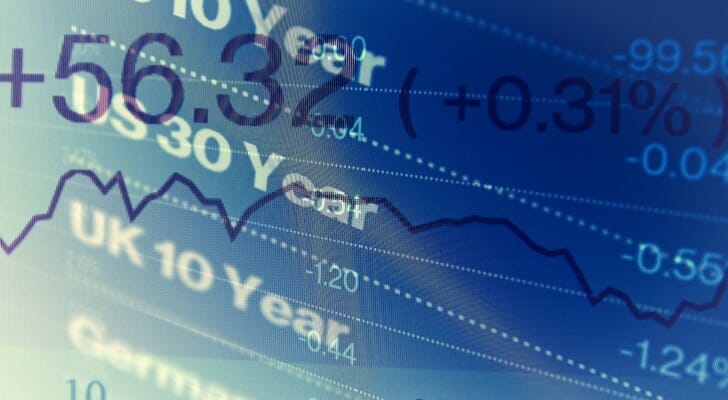 Bonds are a popular security for fixed-income investors and people seeking stability for their portfolios. Understanding how bonds, which are essentially corporate or government IOUs, provide income requires a grasp of the price of a bond and its yield, both of which can fluctuate. Here is how to understand bond prices and bond yields. If you’re looking for a fixed-income component for your investments, work with a financial advisor to find the security that best matches your risk profile, time horizon and goals.
Bonds are a popular security for fixed-income investors and people seeking stability for their portfolios. Understanding how bonds, which are essentially corporate or government IOUs, provide income requires a grasp of the price of a bond and its yield, both of which can fluctuate. Here is how to understand bond prices and bond yields. If you’re looking for a fixed-income component for your investments, work with a financial advisor to find the security that best matches your risk profile, time horizon and goals.
Bond and Bond Price Basics
Bonds have a set term; usually, a bond’s term ranges from one to 30 years. Within this time frame, there are short-term bonds (1-3 years), medium-term bonds (4-10 years) and long-term bonds (10 years or more). At the end of this term, known as the maturity date, the full face value of the bond is paid to investors.
Bond prices are typically expressed as face value, also known as par value. This number indicates what the bond will be worth at maturity, and it’s also used to calculate the bond’s interest payments. The price you pay for a bond may be different from its face value, and will change over the life of the bond, depending on factors like the bond’s time to maturity and the interest rate environment. But the face value does not change. If it was $1,000 at issue, then that’s exactly what the holder of the bond will receive when it matures at the end of its term.
The price of a bond is an estimate of the bond’s present value based on its estimated future value. This pricing works similarly to the way stock pricing does. It shifts depending on external economic and market factors and the issuer’s financial health. As a result, the bond price may sit higher or lower than its face value. They also vary among brokerages as a result of fees, markups or markdowns.
Why Bond Prices and Interest Rates Vary
Bond interest rates and bond prices have an inverse relationship. If a newly issued bond’s interest rate exceeds the interest rate of an older bond of the same duration and type, then the market price of the older bond decreases. That’s because, in comparison to the new bond, the older bond is less lucrative for potential buyers. Bond buyers will only purchase the older bond with its lower interest rate payments if the price of that older bond is discounted.
In contrast, consider a scenario of interest rates generally declining. In such an environment corporations will issue bonds with lower interest rates than older bonds carry. That makes the older bond with the higher interest rate comparatively more attractive. To compensate for that, corporations issuing bonds at a lower rate must offer buyers a discount.
Bond Price and Interest Rate Example
Let’s say you purchase a bond from ABC Corp. that comes with a coupon rate of 5%. Three possibilities follow:
- The prevailing interest rate stays the same as the bond’s coupon rate. The par value is set at 100, which means that buyers will pay the full price for the bond.
- The prevailing interest rates increase. Since the company will issue bonds at the higher interest rate, buyers won’t want to purchase the older bond, with its lower interest rate. Thus, the older bond must sell at a discount to the newer, higher interest rate, bond.
- The prevailing interest rates drop. Because new bonds will come with a lower rate, buyers will pay more for an older bond with its comparatively more generous interest rate.
Factors That Impact Price
There are three key factors to know when dealing with a bond’s price:
- Duration – This matters because of a bond’s sensitivity to changes in interest rates. The longer the maturity or duration, the more sensitive the bond is to interest rate changes. Since bond buyers often purchase these securities for their stability and guaranteed income stream, a longer duration bond is more vulnerable to interest rate changes and, thus, riskier than a shorter duration bond.
- Issuer’s financial health – If an institution with poor credit offers the bond, the company must increase interest rates to draw investors. When the bond comes from a creditworthy corporation, interest rates are generally lower. Check a company’s credit rating with agencies like Moody’s, Standard & Poor’s or Fitch.
- Inflation – This typically leads to higher interest rates and, of course, lower prices. That is because the bond may not keep up with the rate of inflation, so it pays less than the needed amount to stay ahead.
What Is Bond Yield?
If bond prices never changed, a bond’s coupon or nominal yield and its current yield would be identical. But bonds change hands during their lifetimes, and their market prices vary daily for the three reasons mentioned above. That results in its current yield varying from its coupon yield. Yield is determined by taking a bond’s total income and dividing it by its price, whether that is its face value or its current market price. The result is expressed as a percentage.
- Coupon (or Nominal) Yield – Suppose someone buys a one-year bond with a face value of $1,000 bond and an annual coupon of $50. Holding that bond for one year (to maturity) would result in a yield of 5%. That would be its coupon yield or nominal yield.
- Current Yield – But now consider how yield changes if the price of that same bond falls. If the bond mentioned above is resold for $800 it results in a current yield of 6.25%. Of course, if the bond’s price rises above $1,000, its current yield will slip below 5%. As can be seen, price and yield vary.
Besides coupon and current yields, there are several other types of yields that fixed-income investors focus on.
- Yield to Maturity (YTM) – This is the total return investors earn when they hold the bond until it matures. Like the coupon or nominal yield, it’s often quoted as an annual rate but differs from the coupon rate. It does not factor in taxes or associated brokerage costs.
- Yield to Call (YTC) – This is similar to the yield to maturity. It is the overall receivable return if the callable bond owner holds it until its call date.
- Yield to Worst (YTW) – This is the worst yield you can expect. It’s whichever value is lower between a bond’s YTC and YTM. This calculation helps you know the conservative end of a bond’s potential return.
- SEC Yield – This is a yield the Securities and Exchange Commission (SEC) introduced as a standard calculation. Thus, it makes comparing bond funds easier.
- Tax-Equivalent Yield (TEY) – This is the return that a taxable bond needs to match the yield on a comparable tax-exempt bond.
Bond Price vs. Yield: Why It Matters?
Knowing a bond price is not more significant than knowing the yield of a bond. Both play a key role in determining which security to buy. A bond price explains the current value of the purchase with its future value in mind. In contrast, the yield explains the estimated return.
Moreover, understanding how bonds work may provide insight into the stock market’s strength. Thath’s because typically when stocks decrease in value bonds go up. Investors rely on the safety of bonds when the economy slows due to the regular interest payments. Thus, knowledge of bonds may factor into your next investment when the economy shifts.
The Takeaway
 Bonds can be a complicated investment. Buyers on the secondary market often have to monitor the factors that affect them before purchase. So, it’s vital to stay on top of their fluctuations as a bond trader. However, knowing the ways bonds work helps any potential, experienced or beginning investor regardless of whether they invest in bonds. They provide security when diversifying a portfolio and promise more consistent income than other alternatives. Understanding how these securities work will make the decision to buy or not easier in the future.
Bonds can be a complicated investment. Buyers on the secondary market often have to monitor the factors that affect them before purchase. So, it’s vital to stay on top of their fluctuations as a bond trader. However, knowing the ways bonds work helps any potential, experienced or beginning investor regardless of whether they invest in bonds. They provide security when diversifying a portfolio and promise more consistent income than other alternatives. Understanding how these securities work will make the decision to buy or not easier in the future.
Tips for Investing
- Navigating the world of trade and investment individually is possible. But, extra guidance never hurts. A financial advisor can help you restructure your strategy and work towards your goals. With SmartAsset’s matching tool, finding a financial advisor is easy. In only minutes, you will have up to three local advisors fit for the job. If you’re ready, get started now.
- Bond investing is a great way to adjust the risk tolerance of your overall portfolio, but it can be tricky to maintain the exact balance you want between fixed-income and equities. SmartAsset’s asset allocation calculator can help you stay the course you have charted when it comes to adhering to a set breakdown of various securities.
Photo credit: ©iStock.com/TimArbaev, ©iStock.com/G0d4ather, ©iStock.com/gorodenkoff
